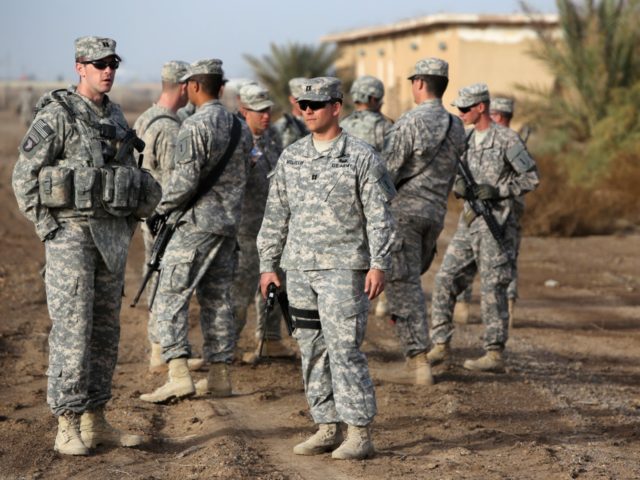The Pentagon is expecting air defense systems and reconnaissance-type aircraft to be part of the roughly 1,000 additional U.S. forces headed to the Middle East in response to actions taken by Iran, a U.S. defense official told Breitbart News on Tuesday.
The official said the deployment will probably consist of Patriot missile defense systems or a similar capability, as well as “manned and unmanned” reconnaissance-type aircraft.
The official said reconnaissance-type aircraft is “very important” for self-defense and deterrence, since Iran is trying to stay “non-attributable in their actions.”
“By having more reconnaissance-type aircraft, we really make it difficult to fly under the radar,” the official said.
The additional 1,000 troops was announced on Monday and follows a deployment of about 1,000 troops just weeks ago – also in response to Iranian threats.
The Trump administration has attributed more than a half dozen attacks in the region since the beginning of May to Iran.
The latest occurred on Thursday, when two shipping vessels — one owned by Norway and the other by Japan — were struck with limpet mines in the Gulf of Oman.
U.S. Central Command on Thursday released a timeline of the attacks, two photos of the damage, and a video of purported Iranian Revolutionary Guard Corps Navy sailors retrieving an unexploded mine from the Japanese tanker.
In the face of skepticism over whether Iran did conduct the attacks, Centcom on Monday released a more detailed timeline of the attacks, additional photos of the damages, and a better photo of the purported Iranian sailors taken by air.
“I think if you put those together and the fact that we had people in those aircraft seeing those ships with their own eyes, I don’t think there’s any doubt in our mind that those ships are IRGC from Iran,” the official said.
The official also said it took the Iranian sailors only eight minutes to remove the unexploded limpet mine lodged in the Japanese tanker, which showed proficiency in handling it that also points to Iran.
“Limpet mines have mechanisms that could make it tamper-proof, right? So they’ve got to know what those systems are to be able to defeat in that short a period of time,” the official said.
The official said there were no visible markings or flags on the sailors’ uniforms or the boat, but that the U.S. military was tracking a number of ships going out of Iran at the time of the incident.
“We’re talking about an area that’s 15 miles off the coast of Iran, we’re talking about very close to their land, and hundreds of miles from other land — those are obviously very small boats,” the official.
“I think there’s plenty of evidence — the uniforms, the weapons aboard the type of vessel — that correspond” to the IRGC.
“So I think it’s pretty clear [that was] an Iranian Gashti patrol boat, with Iranians folks onboard removing an Iranian limpet mine from the side of that ship.”
The official said more evidence will continue to be released in coming days, about the mine itself and what was found aboard the Japanese tanker. The evidence will include more forensics and analysis conducted by explosive ordnance disposal technicians.
Secretary of State Michael Pompeo also pledged to provide additional information about the attacks, but said there should not just be focus on the recent attacks.
“Since the beginning of May, there are now over a half dozen different instances of Iranian attacks in the region – some thwarted, some not successfully thwarted and actually they had an impact,” he said Thursday speaking from Centcom’s headquarters in Tampa, Florida.
Last week at a press conference, Pompeo listed off a series of threats and attacks he attributed to Iran.
He said in early May the IRGC attempted a “covert deployment of modified dhows capable of launching missiles,” and on May 12, 2019, Iran attacked four commercial ships near the Strait of Hormuz.
On May 14, 2019, he said Iran-backed surrogates attacked by armed drones struck two strategically important pipelines in Saudi Arabia.
He also listed a rocket landing near the U.S. embassy in Baghdad’s Green Zone on May 19, and a May 31 car bomb attack in Afghanistan that wounded four U.S. service members, killed four Afghan civilians, and wounded bystanders.
He said on June 12, 2019, Iranian surrogates fired a missile into Saudi Arabia, striking the arrivals terminal of an international airport and wounding 26 people.
On Thursday, Pompeo reiterated the administration’s stance that the U.S. and the president do not want war.
“President Trump does not want war, and we will continue to communicate that message, while doing the things that are necessary to protect American interests in the region,” he said.
The increased activity attributed to Iran began this spring, after the Trump administration designated the IRGC as a terrorist group and declined to waive sanctions on countries still buying oil from Iran.
The moves are part of the Trump administration’s maximum pressure campaign on Iran, to force it back to the negotiating table on its illicit nuclear program.

COMMENTS
Please let us know if you're having issues with commenting.